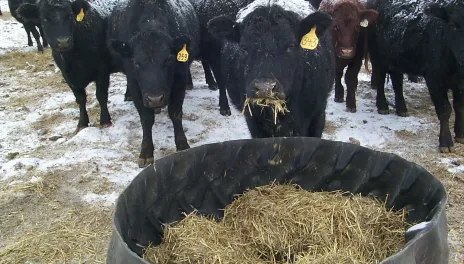High Feed Prices and the Cow Herd
Feed prices have increased 60% or more from a year ago, but most cow herd budgets did not anticipate that increase. Hay prices have also increased drastically in response to reduced hay production due to the widespread drought of 2021. This increase in demand for feed due to drought, combined with an increased worldwide demand for corn grain and soybeans, makes an expensive year to feed the cow herd.
The cattle feedlot industry tries to control feed prices via hedging and contracts, but ultimately, the high cost of feed results in lower calf prices. Lower calf prices create financial distress when the cow herd owner must pay higher feed costs.
The US Department of Agriculture Farm Service Agency Emergency Livestock Relief Program (ELRP) is currently making payments to producers who received assistance from the 2021 Livestock Forage Disaster Program (LFP). https://www.usda.gov/media/press-releases/2022/03/31/usda-provide-payments-livestock-producers-impacted-drought-or.
The winter-feeding period in North Dakota will be extended into late spring. Adverse weather (cold and windy) and drought are delaying pasture growth and subsequent pasture turnout. With reduced feed supplies due to drought and now a longer feeding period, cow herd producers are seeking other feed sources.
North Dakota ethanol and grain milling plants produce a huge volume of feed. While most of this feed is shipped out of state to repeat customers, some is available on the spot market. Deciding what feed to procure is based on availability and freight cost to the ranch, as well as on nutritional value.
The value of feed is mostly based on energy and protein content. The largest feed expense for a cow herd is energy, measured as TDN (total digestible nutrients) or Mcal NEg. Protein costs are the second largest expense.
Prices between feeds are interconnected based on energy and protein content. Feeds tend to be either low-cost energy/high-cost protein or high-cost energy/low-cost protein. One exception to this ‘rule’ is distiller grains. Wet, modified or dried distiller grains are usually low-cost energy AND low-cost protein, and therefore is widely used.
Of course, prices need to be checked routinely since markets fluctuate.
This table compares cost, energy (TDN) and protein (CP) for various feeds. These prices do not include freight costs to the ranch.
| Feed | $/ton (as fed) | $/lb CP (dry matter) | $/lb TDN (dry matter) |
|---|---|---|---|
| Corn | $250 | $1.81 | $0.18 |
| Beet pulp, dried | $200 | $1.34 | $0.18 |
| Canola meal | $400 | $0.69 | $0.35 |
| Distillers grains, wet | $80 | $1.05 | $0.33 |
| Distillers grains, modified | $170 | $1.13 | $0.37 |
| Distillers grains, dried | $275 | $0.57 | $0.19 |
| Soyhulls | $190 | $1.39 | $0.22 |
| Soybean meal | $475 | $0.61 | $0.35 |
| Sunflower meal | $320 | $0.56 | $0.30 |
| Wheat midds | $160 | $0.63 | $0.14 |
Table developed by NDSU Extension Beef Cattle Specialist Zac Carlson and NDSU Extension Livestock Systems Specialist Karl Hoppe.
Karl Hoppe, Ph.D.
Karl.Hoppe@ndsu.edu
Extension Livestock Systems Specialist
